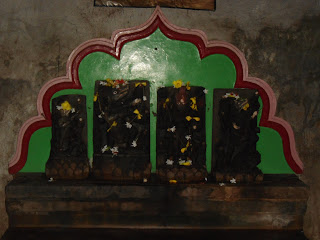 |
| Varahanatha Temple, odishaen.wikipedia.org |
A protected monument maintained by the Archaeological Survey of India ASI), the Varahanatha Temple, also known as Yajna Varaha Temple is located at an elevated place on an island created by two branches of the Vaitarani River, about 1 km (0.62 mi) from Jajpur called as Biraja Kshetra in Odisha. But it is prone to flooding when the rive is in spate . It is home of the sacred temple of goddess Biraja. In the temple complex the main shrine is dedicated to Varaha (meaning boar), an avatar of the God Sri Vishnu. Included in this temple that was built in the 15 and 16th century are many small shrines of other deities such as Shiva, Vishnu, Vimala and others. The temple follows the native architectural style called Kalinga. Somavamshi King, Jajati Kesari` ruled this place in early 10th century. Besides main shrines, there are other shrines in the complex : Gadadhara Vishnu shrine, a shrine to the sun-god Surya, Kasi Biswanath temple (a form of Shiva) and a shrine to saint Chaitanya.
The Hindu mythological legend has it Trinity God Brahma (creator) in the midst of Ashvamedha yajna (fire ritual) - found out that the Vedas (scriptures) had been stolen. So, he sought the help of God Vishnu (protector) to retrieve them to complete the Yajna. God Vishnu took the avatar of a boar (an anthropomorphic form with a boar's head and human body; it is the third avatar to retrieve the earth from the ocean) and emerged from the sacrificial
 |
| Vishnu taking the avtar of Varaha. en.wikipedia.org |
As to the builder of this temple, there are different versions and it is a subject of discussion. It is mentioned that this temple complex came up during the reign of the Suryavamshi Gajapati in the 15–16th century. The chronicle Madala Panji claims the builder of this temple was Prataparudra Deva (reign: 1497-1540). Yet other version mentions about the king's head priest, Kasi Mishra.
Chaitanya Mahaprabhu (1486–1534) is said to have visited this temple in 1510 and sanctified this place. Raghoji I Bhonsle (reign: 1739–1755), the Maratha ruler of Nagpur kingdom carried out major repairs and strengthened the Temple.
 |
| Shrine with foot prints of Chaitanya en.wikipedia.org |
 |
| Varaha temple complex orissabengalyatra2015.wordpress.com |
The vimana is a Rekha deula includes a tall stucture with a shape of sugar loaf) and the jagamohana is a pidha deula - square building with a pyramidal roof). The Vimana as well as the jagamohana are square in shape. The temple is built in ashlar masonry with Khandolite stone, locally available. Invariably many temples are made of this material. The outer wall is panchanga bada, that is, divided into 5 parts (from base to top): pabhaga, talajangha, bandhana, upara jangha and baranda.
 |
| Painted ceiling in Varaha shrine.en.wikipedia.org |
The jagamohana and antarala have not only modern paintings with floral and animal or bird motifs, but also other sculptures. In particular the Jagamohana has beautiful sculptures of many Gods including Shiva, head of Brahma, Giridhari Govardhana (a form of Krishna etc. It also includes images of predominantly Buddhist deity set in the niches. The brackets that support the gandi (temple pinnacle) carry erotic sculptures of male and female figures and figurines of bharabahaka (goblins supporting the roof) and mother and child.The temple has countless independent sculptures of various gods and goddesses in the Hindu pantheon representing different ages.
Hara-Gouri temple: To the south-east of the Varaha Temple, facing south, is a square-shaped pidha deula vimana, built in Kalinga style. It is not well preserved for unknown reasons. The main deity is Ekamukhi Shiva Linga (an iconic image of Shiva) placed on a circular yoni called as Hara-Gouri Shiva (first half of the 15th century). The temple is made of Khandolite stones in Ashlar masonry and lime plastered. The disadvantage is the sanctum being at the lower level, in case of flooding it gets submerged
The east facing Bimala (Vimala) Temple to the south of the Varaha Temple, attracts lots visitors and devotees. Goddess Vimala with a Shiva linga is the main deity. It was built in the early 16th century during the reign of Suryavamshi Gajapati rule. This shrine is also built using Khandolite stones in Ashlar masonry. The shrine is not well maintained.
 |
| Kharakhia Varaha shrine en.wikipedia.org |
The east facing small Mukteswara Temple is to the south of the main temple of Varahanatha. It has a Shiva linga fixed over a circular yoni. Built in the early 16th century during the Gajapati rule, the sanctum here is prone to flooding during the rainy season. Like other temples, this one is made of Khandolite stones set in Ashlar masonry and given a paint of white lime.
Tit-bits:
 |
| The Maa Biraja Templetripadvisor.in |
https://en.wikipedia.org/wiki/Varahanatha_Temple







.webp)

